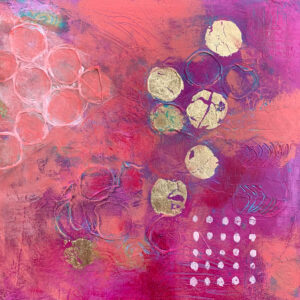
Ah, mindfulness. A word that means a number of things in different contexts, so buzzy in western cultures these days. For me, I am using mindfulness in a pretty traditional Buddhist way. It means paying attention. It is a type of meditation that has many layers of depth, meaning, and activity and ultimately it invokes a state of being in which a person is simply and fully available to the moment. So, when I speak about mindfulness here, I mean this: mindfulness is the activity of full wakefulness. Being fully present in the moment without judgement or discursive thinking.
When painters translate “mindfulness” into the practice of painting, we might describe this as “wonder” or “delight” or “marvel” or “wakeful curiosity.” These describe something of the feeling of being on the knife edge of right now, doing what we love when we push paint around surfaces, making discoveries, continually noting and dropping our expectations and getting lost (or found) in that process.
I think this could be said of any style of painting but for me, wonder and playful wakefulness are immediately accessible in abstract painting. There is less technique available than in say, a plein air outdoor painting of the mountains or in working on a still life of a bowl of apples. In abstract art, technique, composition, and color theory are all at play, though they are engaged with intuitively, and usually indirectly.
This wide-openness of abstract painting – you can do anything, any size, with any media for any reason – can be overwhelming, especially when you first start. Even if you are a trained watercolorist or a professional plein air painter you may still ask: whe

re do I start? WIth what paints, surface, colors, etc? Sometimes the first steps are terrifying. Sometimes they feel liberating. Sometimes they feel like coming home (relaxed, like you’re remembering a feeling or a smell or a sound from long ago). Would you believe that even after quite a few years of doing this, it often feels the same way to start a new project or the next painting?
Ultimately it starts with a mark, a “dot in space,” as Chogyam Trungpa Rinpoche would speak of the practice of art or “Dharma Art” which has influenced many of us over the years. A mark is a gesture, a question or an answer, an articulation of being present. It could be a square of fabric or a bright red slash across a page. It could be a shadowy drawing that

you will paint over or words that are inspiring your work today. And then… another mark! In reference to the first, or in answer/question to it. Then a dialogue begins between you and the work and you start to discover what wants to be communicated.
I’m not sure I know what Dharma Art is, but I can feel a good painting when it arrives. That is the authenticity grounding the work of fellow artists, whether in movement, images, spoken or written words. You feel it, you know that authenticity because it responds to something inside you like a call or a bell or stillness.
Will you take a leap? And start a new fresh creative endeavor? It is waiting for you.
